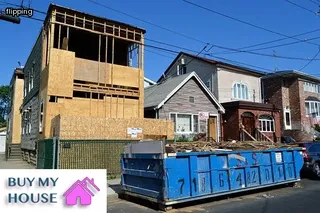Hoarding disorder is a psychological condition that affects an individual's ability to discard or part with possessions. It can be caused by a range of factors including genetics, upbringing and traumatic life events.
Diagnosing the condition is complicated by the fact that people who hoard may not recognize they have a problem, and even if they do, they may be ashamed to seek help. Treatment for hoarding disorder typically involves cognitive behavioural therapy which works to challenge irrational beliefs around items and encourages individuals to de-clutter their living space.
Medication may also be prescribed in more extreme cases. For those managing real estate investments it is important to understand the underlying causes of hoarding disorder so that the most appropriate course of action can be taken when dealing with a hoarder house situation.

Hoarding can pose a significant health risk for real estate investors looking to purchase or renovate hoarder houses. Without proper safety measures, biohazards such as mold spores, rodent droppings, and potentially infectious waste can put both workers and other occupants of the home at risk.
In addition, there is often an overwhelming amount of clutter in these homes that can cause structural damage to walls, ceilings, and floors over time. The first step in mitigating these risks is to understand the scope of the problem by having a professional assess the condition of the house.
Once an assessment is complete, it's important to develop a comprehensive plan that addresses all potential hazards by removing contaminated materials and cleaning surfaces with specialized products designed for biohazard remediation. This should include using personal protective equipment like gloves, face masks, and eye protection during any cleaning or renovation activities.
By taking the necessary precautions when dealing with hoarder houses, real estate investors can protect their workers while also making sure they are providing safe living conditions for anyone who may eventually occupy the property.
Hoarding is a mental health condition that has serious implications for real estate professionals. Hoarding is characterized by an inability to part with possessions and an accumulation of objects that can crowd living spaces, leading to hazardous conditions that can be difficult and expensive to remediate.
It’s important for real estate investors to understand the dynamics of hoarding; not only because of the potential safety risks posed by hoarder houses, but also because of the financial losses that can occur due to difficulties in selling or renting these properties. Awareness of hoarding behavior and its impact is essential for professionals who interact with hoarders or their homes, as they need to be prepared with strategies to manage these situations effectively and safely.
Knowing how to assess hoarder houses and plan accordingly will help investors avoid unexpected surprises and make informed decisions about their investments.

When it comes to uncovering the reality of hoarder houses, real estate investors need to understand the underlying reasons behind compulsive hoarding and its challenges. In many cases, individuals with a hoarding disorder are trying to fill an emotional void in their lives with physical objects and possessions.
Hoarding can also be caused by trauma or a mental health disorder such as depression or anxiety, which can lead to compulsive behavior. The clutter created in hoarder houses can create a number of issues for real estate investors, including financial losses due to decreased market value and repairs that may not be feasible.
Additionally, safety is a major concern because the amount of clutter can cause hazardous living conditions. As a result, real estate investors need to have an understanding of the challenges related to hoarder houses before considering any investments.
When dealing with a serious hoarding issue in a house, it is important for real estate investors to understand the gravity of the situation. The first step is to assess the property for any safety hazards that may be present due to the hoarding.
This could include excessive clutter blocking exits, rotten food left behind, and other unsanitary conditions. Once these issues have been identified, it is important to develop a plan of action to address them.
This should involve hiring specialists who are experienced in cleaning hoarder houses and addressing any structural damage that has been caused by the accumulation of items. It is also important to take into consideration the psychological aspect of hoarding, as this could have an effect on how long it takes to clean up the house and restore it back to its original condition.
Finally, real estate investors should be aware of local laws regarding hoarding as they may need additional permits or licenses in order to work on hoarder houses.

Real estate investors need to be aware of the signs of a hoarder house when considering a potential investment. Hoarder houses can look like any other home on the surface, but they can come with significant complications that can affect the value and cost of the property.
To spot a hoarder house, investors should observe things like large piles of trash, clutter that blocks all pathways, and an abundance of animals, both live and dead. In some cases, there may be evidence of mold growth or water damage due to extreme clutter blocking plumbing fixtures like sinks or toilets.
Investors should also look for increased security measures such as locks on bedroom doors or boards nailed over windows. If any of these signs are present, it is important to investigate further to determine the extent of hoarding and whether additional clean up services are needed before making an offer on a property.
When investing in a hoarder home, it is important to consider the social, psychological and safety factors associated with these homes. Hoarders can often be socially isolated due to their hoarding behaviors, leading to feelings of loneliness and depression.
Furthermore, it is important to recognize the emotional distress that hoarders can experience if they are forced to part with their possessions. From a safety standpoint, hoarder homes can be hazardous due to the clutter and debris that accumulate in the living space.
They can also serve as breeding grounds for insects or rodents, posing a threat to both occupants and visitors. It is therefore essential for real estate investors to understand the reality of hoarder houses before making an investment decision.

Living in a cluttered environment can be incredibly stressful and overwhelming. Hoarder houses are often filled with a staggering amount of clutter, making it difficult to navigate through the home and even more challenging to live in.
It's important for real estate investors to understand how to overcome the struggles associated with living in these environments. First, it's essential to create a plan for organizing and decluttering the space.
This can include throwing away, donating, or selling items that are no longer needed or wanted. Next, setting up simple storage solutions such as shelves and bins can help keep clutter at bay by providing a designated space for items.
Additionally, maintaining regular clean-up sessions is key to keeping the home organized and free from debris. Finally, it may be beneficial to seek professional help if needed.
Professional organizers can provide valuable advice on how best to organize and manage the space so that it's livable and comfortable for all occupants. Uncovering the reality of hoarder houses isn't easy but with some dedication and organization strategies, real estate investors can find success when it comes to managing these spaces.
When it comes to helping people who live in a hoarded house, there are several potential solutions available. Firstly, it is important to understand the underlying causes of hoarding and develop strategies that can help individuals address these issues.
For instance, seeking professional help from a mental health or medical specialist may be beneficial in providing guidance and support. In addition, working with family members and friends to reduce clutter and create an environment of support can be helpful.
Furthermore, education on proper storage techniques can enable individuals to better manage their possessions and keep their homes safe and accessible. Finally, establishing a financial plan that accounts for any additional costs associated with de-cluttering or modifications to the home can be useful in helping people who live in hoarder houses.

Living in a cluttered home environment can be incredibly overwhelming and emotionally taxing for anyone, especially those who are dealing with hoarding disorder. Compulsive hoarding is a condition that affects an estimated 1-3% of the population worldwide and it is characterized by an inability to discard possessions even when they are no longer useful.
This can lead to an accumulation of excessive amounts of clutter that often fills entire homes and creates a chaotic living space. The psychological effects of being surrounded by so much disorganization can be devastating, leading to feelings of isolation, depression, and anxiety.
Hoarder houses can also have a negative impact on family relationships due to the increased tension caused by the chaotic environment. It's important for real estate investors to understand how this type of living situation can affect individuals on an emotional level in order to provide them with the best possible care and support.
Hoarder houses can present especially dangerous living conditions for real estate investors, as they are often filled with hazardous materials, improper wiring, and fire hazards. Many of these homes lack proper sanitation and safety protocols that may be necessary to ensure the health and safety of residents.
Poorly maintained structures can create a heightened risk of collapse or other damage. Additionally, if the hoarder has been living in the house for an extended period of time without proper maintenance, there is a greater chance that mold and other pathogens could have developed in the home’s environment.
It is essential for real estate investors to determine the condition of these homes before making any decisions about purchasing them, as they may not be suitable for occupancy without extensive work. Taking a thorough inventory of all items within the residence is also important, as many hoarders collect items that may be hazardous or illegal to own.
Ultimately, understanding the dangers associated with hoarding and discovering how to mitigate them can help real estate investors make informed decisions about whether or not to invest in such properties.

When selling a house occupied by a hoarder, real estate investors need to be aware of the financial impact that such a sale can have. Hoarder houses usually require extensive and expensive repairs in order to make them livable again, and those costs must be factored into any investment decision.
Selling such a property may also involve costly legal fees, depending on the jurisdiction. Additionally, the investor should consider how much time it will take to get rid of all the clutter and whether or not they are equipped to handle this task alone or if they will need to hire professional help.
Furthermore, they will need to factor in any potential risks associated with selling hoarder houses as these can have an effect on the profitability of their investments. Taking all these factors into consideration is crucial for real estate investors when assessing the financial impact of selling a hoarder house.
When real estate investors come across a hoarder house, it can seem overwhelming and daunting to tackle the clean-up. It is important to first identify local resources that can help with the situation.
Professionals such as certified cleaners, biohazard remediation specialists, and construction teams are available to assist in restoring the property to its original condition. To find these services, investors should research local cleaning companies that specialize in hoarder houses and have experience dealing with hazardous materials.
In some cases, hoarding-specific nonprofits may exist in the area that can provide additional assistance. Before hiring any service provider, it is important for investors to check references from previous clients and make sure they are properly licensed and insured.
Additionally, working with a mental health professional who specializes in hoarding may be beneficial when trying to understand the underlying causes of the problem. With proper planning and preparation, real estate investors should be able to find all of the resources necessary for tackling hoarder houses safely and efficiently.

Investing in a hoarder house can be a lucrative endeavor for many real estate investors. However, it is important to understand the legal consequences of not addressing a severely cluttered home before investing.
When an investor purchases a hoarder home, they are obligated to take care of any existing health and safety issues caused by the excessive clutter. If these issues are not addressed, they could result in significant fines or even criminal charges against the owner or investor.
Additionally, local building codes may require that all homes meet certain standards of cleanliness and organization, so if a hoarder house fails to meet these criteria, the investor may be liable for any repairs or upgrades needed to bring it up to code. Finally, failure to address a hoarded property can lead to civil liability if the hazard posed by neglecting the home causes injury or death.
It is therefore essential for real estate investors to do their due diligence when considering purchasing a hoarder home and ensure that all legal obligations are met before committing to such an investment.
When dealing with a hoarder house, it is important to remember that local authorities need to be involved in order to properly dispose of any hazardous items found in the property. It is not enough for a real estate investor to simply remove the items from the home; working with local authorities ensures that all hazardous materials are disposed of safely and legally.
This includes evaluating any potential risks associated with entering the property, such as dangerous conditions or contamination. Additionally, it’s important to understand how long it will take for authorities to dispose of these items and what kind of fees may be associated with this process.
Understanding local regulations and having an established plan for removal of hazardous materials can help investors better manage their investments and create a safe environment for future occupants.

When evaluating potential buyers for properties that have been occupied by compulsive collectors, real estate investors must consider the unique challenges that come with hoarder houses. Hoarders can create an array of issues such as extensive damage to a property from hoarding materials and hazardous waste, fire hazards from blocked exits, and infestations ranging from rodents to insects.
Gathering information about the history of the residence is critical for ensuring a successful purchase and sale. It is also important to remember that most hoarders are people who are suffering from a mental health disorder so it's essential to approach them with kindness and understanding.
Real estate investors should be aware of their rights when dealing with hoarders in order to protect themselves legally while maintaining a professional yet compassionate attitude towards the seller. Additionally, they should look into any local regulations or laws regarding hoarder houses because there may be special procedures that must be followed in order to complete a sale on such properties.
When it comes to assisting a compulsive collector in removing unwanted items from their home, real estate investors need to explore alternative resources. One of the most overlooked sources of help is community organizations.
Many cities have programs that provide free removal of furniture, appliances and other household goods. Charities and animal shelters may also be willing to take some items off the hands of a hoarder, as well as recycling centers that accept certain materials for repurposing.
Additionally, local businesses such as trash removal services or storage facilities may offer discounts for hoarders who need assistance with disposing of unwanted items. It's important to remember, however, that these services are not always free and investors should research their options thoroughly before deciding on a course of action.
With the right resources in place, real estate investors can help uncover the reality of hoarder houses while providing valuable assistance to individuals in need.
When evaluating whether a house is a hoarder, real estate investors should look for certain telltale signs. Excessive clutter is the most obvious sign that a home may have been taken over by hoarding behavior.
Other indicators might include strong odors (due to mold and mildew), piles of newspapers and magazines, and an overwhelming amount of personal items such as clothing and collectables. In addition, if rooms or areas of the house are blocked off or inaccessible due to excessive possessions, this can be another indication that hoarding has occurred in the home.
If there are signs of animal waste or rotting food inside the dwelling, it can also point to the presence of hoarding. To further assess the situation, investors should conduct an onsite visit with a professional organizer who can provide an accurate assessment of the scope of the problem.
With these simple steps, real estate investors can determine if they're dealing with a hoarder house and develop an appropriate strategy for acquiring it.

House hoarding can be caused by a variety of factors, including mental health issues, physical disabilities and financial stresses. Hoarding is often the result of an underlying psychological issue such as obsessive compulsive disorder (OCD) or anxiety.
People with these conditions may find it difficult to part with items that they consider valuable or important and may end up collecting too many possessions over time. Physical disabilities can also lead to house hoarding, as people who are unable to move around easily may not be able to clean out their home regularly.
Financial stress can be another factor that contributes to hoarding, as people may have difficulty affording a clutter-free life and instead focus on buying more items than they need.
When considering whether a property is inhabited by a hoarder, there are several tell-tale signs to look out for. Clutter and disorganization are common in hoarder houses, with piles of items stacked around the home.
These items may often be broken or unusable, but still kept by the hoarding individual. Other signs include an overwhelming smell that may indicate rotting food or pet waste, walls and floors that are not visible due to the amount of stuff inside, and an excessive number of animals living in the house.
Hoarders may also have large amounts of mail piled up, as well as trash bags filled with newspapers, cardboard boxes, and other materials that cannot easily be disposed of. Additionally, hoarders tend to collect items that others might consider useless or valueless such as empty containers or old magazines.
Understanding these signs can help real estate investors determine if a property is inhabited by a hoarder before they agree to purchase it.
A hoarder home is a dwelling that has become severely cluttered, resulting in health and safety risks for those living there. Hoarding often occurs when an individual acquires more items than they are able to manage or store properly.
As the clutter accumulates, it often begins to impede on the functionality of the house, creating hazardous conditions that can lead to potential fire hazards. Hoarders tend to be emotionally attached to their possessions, making it extremely difficult for them to discard items and keep their homes organized and tidy.
For real estate investors looking to purchase a hoarder home, it is important to understand the reality of living with a hoarder and how this kind of property may differ from others on the market.